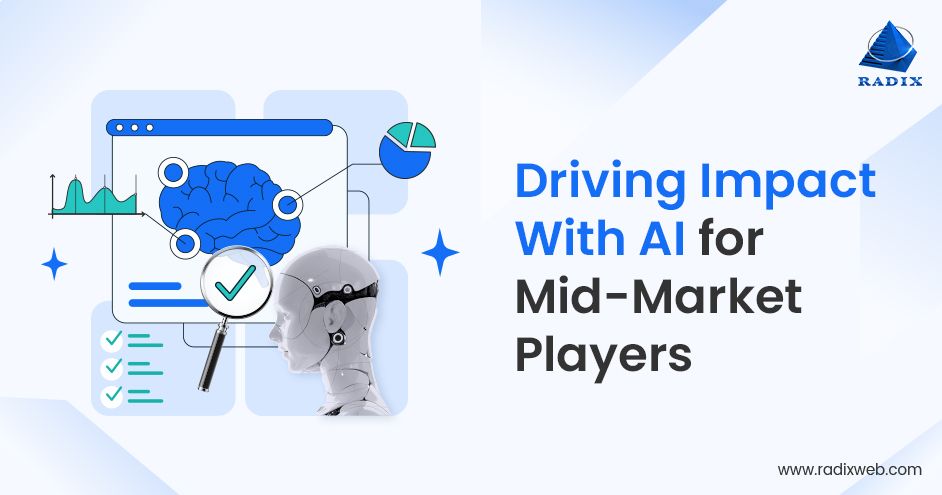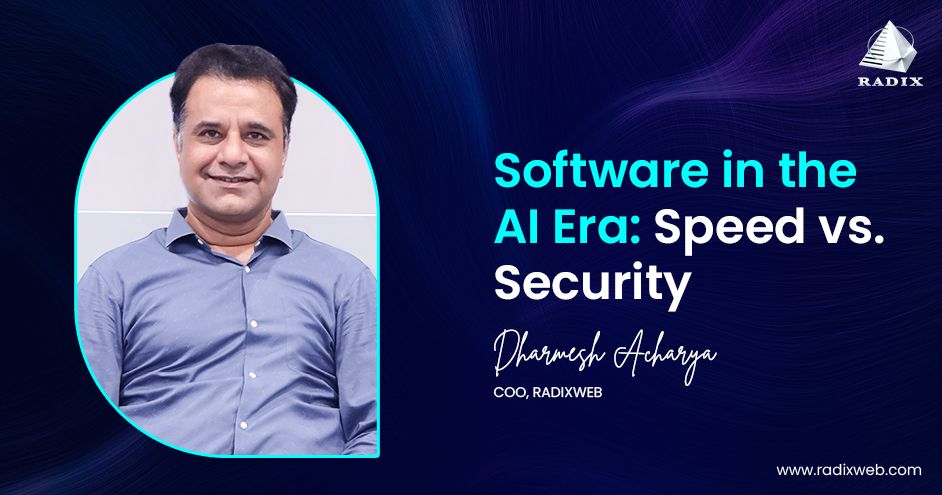Read More

Skip Setup Headaches and Start Your Project Fast - Download Free Boilerplates
Mid-Market Firms Can Punch Above Their Weight with AI - Our COO Explains How

Sarrah Pitaliya

AI isn’t a race won by those with the biggest budgets. It’s led by those who can move with clarity. Mid-sized businesses - often viewed as less equipped to leverage AI - are, in many ways, structurally more ready than larger enterprises. Their leaner teams, more focused priorities, and tighter feedback loops allow them to act faster, align quicker, and implement more deliberately.
When I spoke with Dharmesh Acharya, our COO at Radixweb, about AI adoption across mid-market firms, the conversation quickly moved away from tools and toward organizational behavior.

He shared a grounded view of how real businesses (not just tech-forward ones) can use AI to strengthen their core operations, without overhauling their entire model. What follows is a distillation of that discussion: part strategic roadmap, part reality check, and entirely actionable.
AI isn’t just a competitive advantage for the tech elite. It’s a force multiplier for the mid-market. AI can help mid-market businesses punch above their weight. Not by doing more, but by doing what matters, faster and with greater clarity.
Start with What Hurts and Fix It Fast
Acharya emphasized that the best AI outcomes begin not with strategy decks or transformation programs, but with a single, clearly defined bottleneck.
When mid-sized firms struggle to start, it’s usually not because they lack awareness or access to the right tools. More often, it’s internal ambiguity. No clear ownership, questions about whether the data is “good enough,” uncertainty about where to focus first, and tech partners who are mere vendors. In practice, though, most meaningful AI initiatives are driven by operational friction: too many manual tasks, spiraling costs, or decisions that rely on instinct rather than patterns. The most successful pilots, he said, aren’t built to prove technical capability, they’re scoped to remove a specific pain point.
“The firms that succeed don’t start with AI. They start with a problem they can no longer afford to ignore.”
This is where mid-market companies may have an edge they often overlook. Unlike sprawling enterprises, they’re closer to their problems. They don’t need cross-functional task forces to figure out what’s broken. It’s usually felt at the leadership level, daily. But that advantage only plays out if they act on it. Too often, clarity is sacrificed in the name of preparing for scale. As Acharya put it, the opportunity is to treat AI not as a sweeping change program, but as a sharp tool to cut operational drag.
Execution Is the Differentiator. Not the Technology
When it comes to scaling beyond the first pilot, execution patterns matter far more than the tech stack. Acharya has seen this repeatedly: the companies that make progress tend to do three things well.
First, they ensure business-side ownership. If the AI project lives only in IT, it almost always stalls. Business leaders who feel the impact of inefficiency need to be shaping the solution, not just signing off on it.
Second, they pick use cases that are urgent and consequential, processes where even small improvements create visible outcomes. These aren’t innovation showcases; they’re practical changes to how teams work. Of course, speed shouldn’t mean you backtrack on security either. Acharya mentioned this earlier also when discussing AI in software development at large.
And third, they plan for reinvestment. When automation saves time, there should be a plan for what to do with that capacity, whether that means improving customer responsiveness, speeding up internal reviews, or expanding service coverage. Otherwise, the value gets lost in the system.
I asked Acharya what mid-sized firms should actually do today if they wanted to start small, with purpose. His view was simple but specific.
“Start by identifying two or three workflows that are consuming disproportionate effort or decision time. This could be anything from proposal generation to internal support ticketing. Then, look at what data is already being captured, even if it’s imperfect. A few hundred historical records or CRM logs are often enough for a narrow-scope model.”
The point, he explained, is not to aim for predictive brilliance, but operational efficiency.
Finally, don’t overinvest in building an AI team from day one. What’s needed is internal clarity and commitment to solving the problem, external expertise can handle the modeling.
“Clarity beats capability. The firms that win know exactly where the friction is and they move.”
He also cautioned against waiting for readiness. AI maturity models can be useful, but they’re often misapplied. Instead of investing time in building a perfect roadmap, he suggested treating the pilot as the roadmap itself. Learn by doing. Adjust as needed. Prove value quickly and build momentum from there.
Still, none of this is just about technology. Acharya was clear that deploying AI shifts how decisions are made. And that means people (not systems!) must adapt. Successful firms treat change management as core to AI delivery. They train managers, establish oversight norms, and align incentives around adoption. Without that, the pilot becomes a siloed proof of concept—useful, but ultimately discarded.
“You’re not just deploying models. You’re changing how decisions get made. The human factor matters more than the algorithm.”
At the end of our conversation, Acharya returned to a recurring point: success with AI is less about budgets, and more about decisiveness. The companies that move are not the ones with the best pitch decks or biggest data sets. They’re the ones with clarity and the courage to act on it.

This isn’t just a perspective. It’s something we’ve seen proven, time and again, at Radixweb. Mid-sized businesses that move early don’t wait for perfect conditions. They focus on a real constraint, solve it with intent, and build momentum from there. The advantage isn’t in having more resources, it’s in acting with clarity. If this conversation sparked something for you, don’t wait to have it all figured out. Start with what’s real. Start with what’s holding you back. And commit to moving forward. One focused step at a time. And if you need a guide by your side, feel free to connect with us here.
Ready to brush up on something new? We've got more to read right this way.



